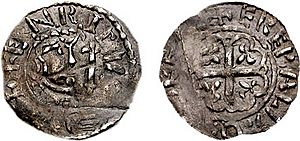Mints of Scotland facts for kids
Scotland had several places called 'mints' where they made coins. These coins were used all over Scotland. The main mint was in Edinburgh, the capital city. It started making coins when King David I ruled (from 1124 to 1153). This Edinburgh mint was also the last one to close, in the 1800s.
| Penny of Henry of Scotland | |
|---|---|
 |
|
| hENRICVS •[F RE?], crowned bust right, sceptre before | +EREBALD: ON [C]OREB:, cross moline with fleur in each angle within tressure |
| AR 1,18 gm, 10h. Corbridge mint; moneyer: (H)erebald | |
The very first Scottish mint was probably in Carlisle in 1136. King David I started making coins there after he took control of the city. Later, mints in Bamburgh and Corbridge were run by David's son, Henry. These towns are in Northumberland and later went back under English control.
When King Alexander III ruled (1249–1286), Scotland had 16 different mints! But by the time King James IV was in charge (1488–1513), only the Edinburgh mint was still working. After that, the only other mint that opened was in Stirling. Queen Mary (Mary, Queen of Scots) had special coins called bawbees made there.
Where the Mints Were Located
Until 1559, a mint was located on the grounds of Holyrood House in Edinburgh. This was a royal palace. From 1559 to 1574, the mint moved inside Edinburgh Castle. This was done for safety reasons, to protect the valuable coins and equipment.
In 1570, a leader named Regent Morton made some coins at Dalkeith Castle. These coins were made with cheaper metals. He used them to pay for building projects for the Crown, like work on Edinburgh Castle. But in 1575, he made these coins worth less, which made people who had them very angry.
From 1574 until 1707, the Edinburgh mint was on a street called the Cowgate. It was near a place called South Grays Close. The buildings where the mint was located later belonged to the mint master, Thomas Acheson. These buildings were taken down in 1877. Today, a street nearby is named "Coinyie House Close" to remember where the mint once stood.
When Coin Making Stopped
Making coins in Scotland officially stopped in 1709. The Edinburgh Mint made its last batch of coins then. Even though coin production ended, some of the main officials of the mint kept their jobs for another hundred years, until 1814. The mint was finally closed down in 1817 and sold in 1830. The special title of 'Governor of the Mint of Scotland' was eventually removed in 1971.
Scottish Mints Through History
This table shows which Scottish towns had mints and when they were active. An 'x' means a mint was working in that town during that ruler's time.
| David I | earl Henry |
Malcom IV | William | Alexander II | Alexander III | John Baliol |
Robert Bruce |
David II | Robert II | Robert III | James I | James II | James III | James IV | James V | Mary I | |
| Aberdeen | x | x | x | x | x | x | |||||||||||
| Ayr | x | ||||||||||||||||
| Bamborough | x | ||||||||||||||||
| Berwick | x | x | x | x | x | ||||||||||||
| Carlisle | x | x | |||||||||||||||
| Corbridge | x | ||||||||||||||||
| Dumbarton | x | ||||||||||||||||
| Dunbar | x | x | |||||||||||||||
| Dundee | x | ||||||||||||||||
| Edinburgh | x | x | x | x | x | x | x | x | x | x | x | x | |||||
| Forfar | x | ||||||||||||||||
| Forres | x | ||||||||||||||||
| Glasgow | x | ||||||||||||||||
| Hamer | x | ||||||||||||||||
| Inverness | x | x | |||||||||||||||
| Jedburgh | x | ||||||||||||||||
| Kelso | x | ||||||||||||||||
| Kinghorn | x | ||||||||||||||||
| Lanark | x | ||||||||||||||||
| Linlithgow | x | x | |||||||||||||||
| Montrose | x | ||||||||||||||||
| Perth | x | x | x | x | x | x | |||||||||||
| Roxburgh | x | x | x | x | x | ||||||||||||
| St Andrews | x | x | |||||||||||||||
| Stirling | x | x | x | x | x |


